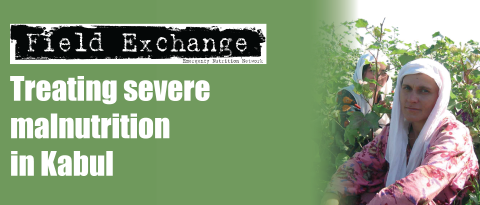Issue 24 Editorial
All the field articles in this issue come from either AAH or ACF staff. Two pieces deal with programmes targeted at the severely malnourished. Thierry Muriele writes about the success of a Home Based Treatment regime in Kabul where the social and cultural attitudes to women made it very difficult for them to attend therapeutic feeding centres. Programme staff therefore chose to implement a HBC regime which led to a considerable improvement in default rates. Carlos Navarro writes about a trial of RUTF (BP100) in a TFC setting in Sierra Leone comparing outcome with F100. The results show equivalent success in terms of weight gain for the RUTF product. The two other field articles deal with programmes in former Soviet Union countries - Tajikistan and Azerbaijan. Carmello Gallardo describes AAH efforts to implement Income Generating Activities (IGAs) for vulnerable groups in Azerbaijan following collapse of the Soviet Union and low level war in the region. She describes how AAH implemented a combination of short and long-term IGAs to bolster food security, each with varying degrees of flexibility, risk and profitability. The adopted strategy was similar to holding a mixed investment portfolio to maximise gain but minimise risk. Toby Porteous writes about the limited success of the land reform process in Tajikistan. The land reform programme aimed to provide farmers with their own small farms on which to grow foods/crops of their choice. However, it appears that only 3.5% of households surveyed had moved away from large collective farms. Reasons given for the limited success included lack of knowledge of new land rights and how to apply for land, pressure to grow certain crops like cotton, refusal of applications and indebtedness leading to the need to grow crops on large collective farms. Recommendations included, training for farmers on land laws and rights, instituting mechanisms for legal redress, assumption of debt by government, and the need for monitoring the land reform process.
This issue of Field Exchange also has a broad range of research and review summaries. Much of this material is novel and a valuable contribution to the literature. Work on the impact of a fortified spread supplement amongst Sarahawi refugees shows how in contrast to conventional wisdom a fortified supplement can significantly contribute to catch-up growth up until 6 years of age. Claudine Prudhon from the NCIS in Geneva submitted a study based on nutrition surveys received by the NICS. The piece highlights the difficulty of accounting for oedema in surveys. She argues that Epi Info 6 is not sufficiently 'user friendly' with regard to accounting for oedema so that almost one third of surveys which used this software for analysis miscalculated prevalence of malnutrition. A review by HPG of the changing role of food aid policy in protracted crises highlights how the increasing number of protracted crises in the world poses significant intellectual and institutional challenges especially as more development agencies start to programme in these settings.
This issue also summaries a series of reviews on complex emergencies carried recently in the LANCET. While these reviews identify gaps and challenges (many of which have already been identified in the literature) they contain few practical ideas as to how to advance knowledge or move debate forward.
Finally, there is a research piece describing a recent MSF mortality survey in Darfur. This study raises a critical issue which as yet is not being fully acknowledged or addressed by actors in the emergency food and nutrition sector. The concluding paragraph of this piece states that 'The high mortality and family separation amount to demographic catastrophe'. However, 'proof of genocide would require documentation of intent by perpetrators'.
This is a revealing observation and one that should raise concern amongst health professionals. While the aid world has struggled for years with definitions or cut-offs marking end points, e.g. what is a food emergency or famine, little effort has been made amongst emergency food and nutrition specialists to define genocide. This is surprising given that starvation whether by omission or commission is often a central strategy of those intent on genocide. Arguably, arriving at consensus over a definition of genocide is a more important definitional quest than has been ongoing for famine, as consensus will inevitably contribute to more timely political pressure for action as and when these events occur. Definitional clarity is surely something for which public nutritionists must begin to advocate. Events in Darfur and before this, Rwanda, might have unfurled in a far more positive manner had there been greater consensus and clarity about what constituted genocide. In a world where the natural law of politics is 'not to act' unless there is significant political pressure, it is vital that technicians do all within their power to remove ambiguity and sharpen focus on the processes and end points that define genocide so that political pressure can be mobilised. Apart from witnessing (temoinage) and providing hard data on levels of malnutrition, its causes, and related mortality, this is probably the greatest contribution that public nutritionists can make to preventing future genocide.
We hope you enjoy this issue of Field Exchange
Jeremy Shoham (editor)
Any contributions, ideas or topics for future issues of Field Exchange? Contact the editorial team on email: office@ennonline.net
Imported from FEX website


